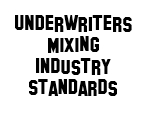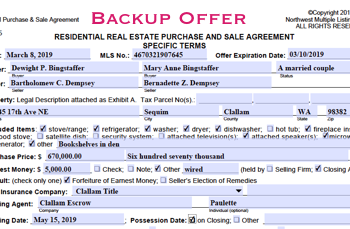Buyers of Sequim homes have had their challenges since the collapse of the mortgage industry and the real estate market. Even eminently qualified buyers of Sequim homes have had to jump unreasonable hurdles placed in their paths by evolving mortgage standards, including changing appraisal standards, and new processes in the underwriting industry. All of this has not only hurt buyer’s, it has literally destroyed the ability of many sellers to get their Sequim homes sold.
A new threat has arrived on the scene that hinders both buyers and sellers. No one is talking about this, and I believe this is the first time this issue has been exposed and articulated in writing.
Nearly everyone is aware of the higher standards that mortgage underwriters are requiring of buyers. I don’t think any of us has a problem with the mortgage industry and their underwriters enforcing higher standards. They should have been paying attention to the standards before their industry collapsed. Who could argue with an underwriter who wants a buyer to be qualified and proof that the property will secure the debt? No one. This is not the problem. The problem is irrational and unreasonable demands by underwriters and their industry’s evolving rules and procedures.
paying attention to the standards before their industry collapsed. Who could argue with an underwriter who wants a buyer to be qualified and proof that the property will secure the debt? No one. This is not the problem. The problem is irrational and unreasonable demands by underwriters and their industry’s evolving rules and procedures.
Underwriters Killing the Sale of Sequim Homes
This is a true story. A buyer makes an offer on a Sequim home, and the seller accepts the offer. We have mutual acceptance. We have a closing date, and we have a few contingencies to clear up before the closing date. All perfectly normal, right? The standard inspections include a septic inspection, a home inspection, but not a well inspection because the home is on a community well system. The septic needs a new septic tank. The seller agrees to replace it. The home inspection goes very well, and the home inspector notes a few items on his report, which is normal. Every home inspection report will have some items enumerated as the job of the home inspector is to find any possible items that may or could need to be replaced. Obvious code violations will be noted in the report. All that is good. The buyers want to know if there are any issues of potential concern. That’s why they hire the home inspector and pay him $400.
This home inspection report noted a few minor items. There was an outlet in the kitchen that didn’t have the mini-breaker switch built into it. The door to the garage was a steel door but not a solid core door. The composition shingle roof was seven years old and would need a few minor repairs. And the hot water heater did not produce hot water. It was suspected that the heater element was burned out. All this is normal and these minor items have always been handled between buyer and seller by negotiating who would pay for the repairs, if any. The form 35, which is the home inspection addendum, creates the need for a form 35R after the home inspection report, which addresses the needed repairs and asks the seller to pay for them. The seller has an opportunity to agree or to seek to compromise the sharing of the cost of repairs. This is the way we’ve been doing it for decades, and it is all a simple contract matter between the buyer and seller.
Enter the underwriter. The underwriter looked at the form 35R and saw that there was a home inspection report and that there were listed items that might need repair. They were all minor, but the underwriter demanded a copy of the full home inspection report. Here’s where the underwriter went off the reservation.
The underwriter required as a condition of him approving the loan, replacement of the kitchen outlet, the door from the kitchen to the garage, replacement of the hot water heater, and a certification by a roofer that the roof is good for at least two years. At first blush none of that sounds unreasonable, but here is the danger and the trap for all of us.
Sequim Homes and Underwriter Standards
The underwriter’s job is to make sure the buyer is financially qualified to make monthly payments and pay off the loan and to make sure the property is good security for the debt. In this case the buyer was putting down $100,000 cash on a $150,000 home. The buyer had perfect credit and a nice retirement income. So there was no problem with the buyer. The only thing left for the underwriter was to make sure that this home, which appraised for above the purchase price, would be good security for the $50,000 loan. Seems pretty simple, doesn’t it? If you were the underwriter, would you feel secure making a $50,000 loan on a home that appraised for more than $150,000 when the buyer was putting $100,000 down? Absolutely. You would think this would be a no-brainer and the loan approval would be easy. Based on loan to value ratio, this loan was only 33% of the appraised value.
While the underwriter’s review of the home inspection report seems harmless on its face, here’s what was really happening. The underwriter confused and mixed the standards for underwriting a loan with the standards for a home inspection. These are two completely different industries with completely different purposes.
The underwriter must determine the financial worthiness of the buyer and make sure the real estate is good security for the loan. The underwriter orders an appraisal to determine it’s value. The underwriter works for the mortgage company or bank, and indirectly works for the secondary mortgage market and the derivatives market. Everyone in those industries is concerned about the buyer’s ability to make the monthly payments and to be secure in the real estate if the buyer cannot.
The home inspector works for the buyer, and has a completely different purpose and different standards. The home inspector’s job is not to make sure the home’s value secures the loan. The home inspector seeks to answer a simple question for the buyer, “Does this home have any structural or other mechanical issues that could effect my intended use and comfort in this home?” The buyer wants to know if the home has any problems. The buyer is already convinced of its value, and is willing to pay a home inspector $400 to find out if there is anything whatsoever that the home inspector can find wrong or even potentially wrong, even the most minute of issues.
Here’s where the underwriter went wrong. The underwriter made the home inspection report part of his underwriting standards. He incorporated the home inspection report into his underwriting requirements. He essentially made the home inspection report equal to the appraisal. This mixed two completely different industry standards together for one underwriting purpose.
The home inspection is not written for the purpose of determining the fair market value of the home. It is written to satisfy the buyer’s curiosity about the comfort of the home and the working order of mechanical systems. A buyer is not legally obligated to order a home inspection, and if he doesn’t, an underwriter cannot have one. But when a buyer orders one, the underwriters are making these reports part of the underwriter standards.
This means if the underwriter demands a copy of the home inspection report, the underwriter can delay the closing for weeks or months as he requires various repairs that have no effect at all on the security value of the home for lending purposes. An underwriter may require that outlets be replaced, that doors be replaced, and that a licensed and bonded roofing contractor certify that a roof will last for two years. Based on the home inspection report, an underwriter may irrationally demand that a step be repaired, that carpet be replaced, that a cabinet hinge be replaced, that a hot water heater be fixed, or that a window with a broken seal be replaced. Repairs based on appraisal items is not unusual, but what we have now is repairs required based on non-appraisal items in a home inspection report. Is the underwriter in a good mood today or a bad mood? You’d better hope he is in a good mood, because no one can talk to him. We don’t have his phone number or even his location in the country. An underwriter not only has the power of God (and is just as inaccessible), he also can be completely irrational and buyers and sellers have no recourse.
In the transaction I write about here, the entire transaction was at risk because the underwriter lost his focus on his core responsibility and went completely off the reservation to require home inspection repairs that had nothing whatsoever to do with loan underwriting standards. The underwriter was happy with the buyer’s qualifications, and the underwriter was happy with the appraisal. When the underwriter learned there was an home inspection report, this is when he got off track and lost his focus. The implications of this are that in any transaction, an underwriter may require repairs that neither the buyer nor seller are willing to pay for, or the underwriter may require repairs that exceed the time limits for funding the loan.
This has some appraisers now referencing the home inspection report in their appraisal report, and when an underwriter reads an appraisal that references a home inspection report, they think they are obligated to demand a copy of the full home inspection report.
So what is the practical result of this new nightmare for buyers and sellers? Whenever laws get ridiculous and create hurdles for reasonable people causing great financial hardship, people start figuring out ways to get around the bureaucrats. Underwriters who are bringing in the home inspection report as part of their underwriter standards are causing great stress and financial hardship for both buyers and sellers, who might lose the transaction if it cannot close on time. An underwriter has the power to literally kill the deal when he brings in the home inspection report using different standards than those in his own industry.
If an underwriter delays or kills a transaction based on a home inspection report, he is also taking money from the buying Realtor and the selling Realtor, and let’s not forget the loan officer doesn’t get paid if the transaction doesn’t close.
There are many people who are adversely effected by the foolish and unreasonable requirements of an underwriter who has lost his focus on his fundamental responsibilities. They will figure out how to get around that underwriter. What will they do? What are they doing?
Buyers, sellers, Realtors, and loan officers will stop making any mention of a home inspection report. They may have a form 35 home inspection addendum which gives the buyer the right to walk away if something turns out to be wrong with the house, but they wont’ produce or mention a home inspection report in a form 35R, and they won’t have an addendum in writing that mentions anything about a home inspection or any repairs or any credit at closing or any adjustment to the purchase price. In other words, they won’t put anything in writing that would put the underwriter on notice that there ever was a home inspection report.
This means a qualified buyer and a good appraisal will be the only things the underwriter has to look at, which is as it always has been and as it should be today. This gets back to basic underwriter standards, and eliminates the underwriter’s inappropriate mixing of two industry standards with different purposes in such a way that the entire transaction could be at risk or even killed.
The devil is in the details, of course, so how a Realtor and his clients will handle this legally and ethically is another matter. Some will do so dishonestly, but they will get the deal closed. Others, like me, will figure out how to do it right. It’s hard enough to bring a buyer and seller together today, to get a good appraisal, and to get an underwriter to sign off. We don’t need underwriters going off half cocked to make up new rules that are not required, not written down, confuse two industry standards, and that give them the power of God to kill any transaction anytime they want. But all this is going to require some serious and careful contract drafting, isn’t it? This is one time I am glad I was a real estate attorney for 20 years.
If you’re a buyer or a seller, be absolutely certain you know exactly how you will handle several issues: 1.) the home inspection addendum, 2.) the form 35R Inspection Response, 3.) the language in the 35R and how you address any items that need repair, and 4.) whether and how you negotiate a credit at closing or reduce the purchase price.
Last Updated on June 6, 2024 by Chuck Marunde

































This article scares the hell out of me. Makes you appreciate your present, mortgage free home even more. At retirement, who wants to get involved in this mortgage mess when it is just as easy to rent a summer home. Someone once made this comment to me: “New gigs can become old pretty quick” Sometimes, we find ourselves in the dream phase, and when reality kicks in, it may be too late to wake up.
Solution: Rent a place for a couple of months, when you have had enough, you know you always have your home to return to. There are numerous vacation rentals in Sequim or Port Angels with stunning views and more. Why buy ?????